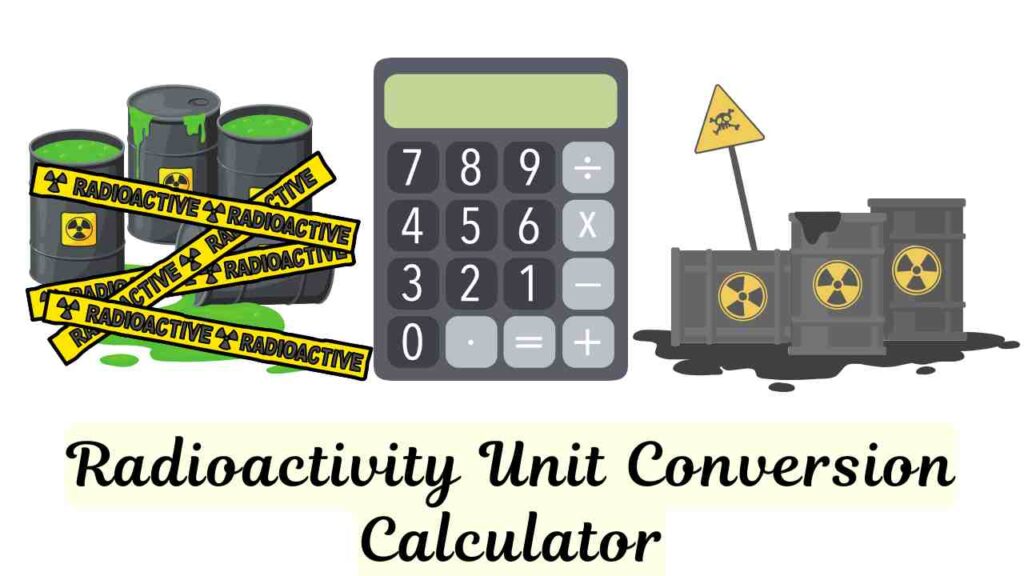Radioactivity Unit Converter
Radioactivity is a fascinating yet complex phenomenon that plays a critical role in fields ranging from nuclear physics and medical imaging to environmental science and energy production. Understanding and converting between radioactivity units is essential for professionals working in these areas, as well as for individuals seeking to comprehend the effects of radiation exposure. However, switching between units like Becquerel (Bq), Curie (Ci), Rutherford (Rd), and their derivatives can be challenging without the right tools.
To simplify this process, we’ve developed a free, intuitive online Radioactivity Unit Conversion Calculator that allows you to convert between any radioactivity units instantly. In this blog post, we’ll explore why radioactivity conversions matter, common scenarios where they’re needed, and how this calculator can help you work smarter and ensure accuracy in your calculations.
Radioactivity Unit Conversion Calculator
Table of Contents
Radioactivity measures the rate at which unstable atomic nuclei decay, releasing energy in the form of radiation. The most commonly used units include:
- Becquerel (Bq) : The SI unit of radioactivity, representing one decay per second.
- Curie (Ci) : A larger unit equivalent to 3.7 × 10¹⁰ decays per second, historically based on the activity of 1 gram of radium.
- Rutherford (Rd) : Equal to 1 million decays per second, often used in older scientific literature.
- Gigabecquerel (GBq) and Terabecquerel (TBq) : Larger multiples of Becquerels, used for high-activity sources.
- Millicurie (mCi) , Microcurie (µCi) , and Nanocurie (nCi) : Smaller fractions of Curies, often used in medical and environmental applications.
Each unit serves a specific purpose, and converting between them ensures consistency and accuracy in calculations.
Why Convert Radioactivity Units?
Converting between radioactivity units is crucial for several reasons:
- Cross-Disciplinary Work : Different fields use different units. For example, physicists might work in Becquerels, while healthcare professionals use Curies or microcuries to measure radiopharmaceuticals.
- Precision in Measurements : High-precision applications, such as cancer treatment planning or environmental monitoring, require accurate conversions between units.
- Compatibility : When integrating systems or tools that use different units, conversions ensure seamless operation.
- Education and Research : Students and researchers often need to compare data across multiple scales, making unit conversions indispensable.
- Real-World Applications : From assessing radiation safety to designing nuclear reactors, unit conversions play a vital role in countless industries.
Introducing the Radioactivity Unit Conversion Calculator
To simplify the process of converting radioactivity units, we’ve developed a free, easy-to-use online Radioactivity Unit Conversion Calculator . This tool allows you to convert between any two units instantly while also providing a comprehensive list of all possible conversions for your input value.
How It Works
- Enter the Value : Input the numerical value you want to convert.
- Select "From" and "To" Units : Choose the unit you’re converting from (e.g., Curie) and the unit you’re converting to (e.g., Becquerel).
- Click "Convert" : The calculator will display the converted result for your selected "to" unit.
- View All Conversions : Below the main result, you’ll find a grid showing the equivalent values in all supported units, giving you a complete overview.
Example Conversion
Let’s say you have a radioactive sample with an activity of 1 Curie (Ci) and need to determine its value in Becquerels:
- Enter
1in the input field. - Select "Curie (Ci)" as the "from" unit and "Becquerel (Bq)" as the "to" unit.
- Click "Convert."
The calculator will show:
- Main Result :
1 Curie (Ci) = 3.7e10 Becquerel (Bq) - All Results Grid : Becquerel (Bq): 3.7e10Curie (Ci): 1Rutherford (Rd): 37000Gigabecquerel (GBq): 37Terabecquerel (TBq): 0.037Millicurie (mCi): 1000Microcurie (µCi): 1000000Nanocurie (nCi): 1000000000
This instant overview saves time and ensures accuracy in your calculations.
Key Features of the Calculator

- Dynamic Dropdowns : Automatically populated with all supported units for quick selection.
- Responsive Design : Works seamlessly on desktops, tablets, and mobile devices.
- Scientific Precision : Handles large and small numbers with ease, displaying results in either standard or scientific notation.
- Comprehensive Results : Provides not just the specific conversion but also a full breakdown of all equivalent values.
- User-Friendly Interface : Clean, intuitive design with hover effects for better readability.
Practical Applications of the Calculator
Here are some real-world scenarios where this calculator can be invaluable:
- Nuclear Physics : Convert between Becquerels and Curies when studying radioactive decay rates or designing experiments.
- Medical Imaging : Translate activity levels of radiopharmaceuticals into appropriate units for dosimetry calculations.
- Environmental Science : Measure background radiation levels in Becquerels or Gigabecquerels.
- Radiation Protection : Assess exposure risks by converting between microcuries and nanocuries.
- Education : Help students understand the relationships between different radioactivity units through hands-on exploration.
Tips for Using the Calculator Effectively
- Double-Check Inputs : Ensure the value and units you enter are correct to avoid errors.
- Understand Context : Know which unit is most appropriate for your application before performing conversions.
- Explore All Results : Use the "All Results" grid to gain insights into how different units compare.
- Bookmark the Tool : Save the calculator link for quick access whenever you need it.
Conclusion
Understanding radioactivity units and their conversions is a critical skill in many fields, from nuclear physics and medical imaging to environmental science and education. With our Radioactivity Unit Conversion Calculator , you can streamline this process and focus on what truly matters—your work. Whether you’re assessing patient safety, monitoring environmental radiation, or solving complex problems in physics, this tool empowers you to handle radioactivity conversions with confidence and precision.